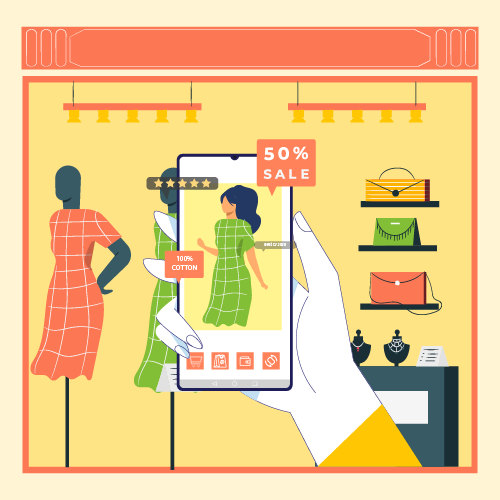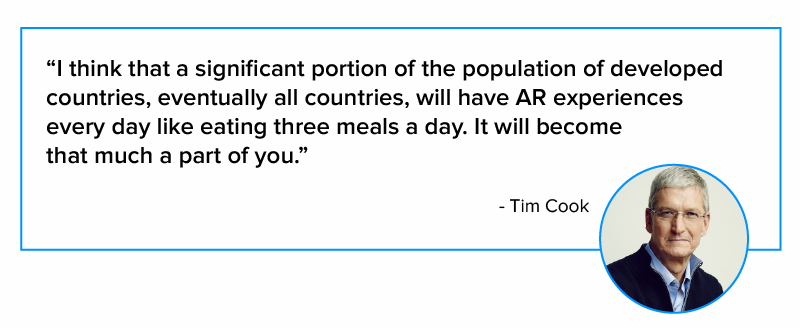How Augmented Reality is Transforming the Retail Industry?
The Augmented Reality market has grown so colossal that predictions estimate its value to reach $61.4 billion by 2023. AR has permeated into (almost) every field which includes healthcare, gaming, entertainment, retail, digital marketing, education, utilities, et al.
When we narrow it down to Augmented Reality in retail, Wikitude approximates that 32% of shoppers are regular users of AR and 73% of smartphone AR users are highly content with the experiences. Such Augmented Reality retail statistics prove how the market has accepted the technology and is exponentially growing with its help.
But before we move on to that, let’s see the problems with traditional retail marketing.
The problem with traditional retail marketing
Earlier marketing forms needed a makeover with time as so many technological developments and demand and supply for goods were increasing. Retail shops grew bigger, more people flogged in and the system became more organized. Here are some points that highlight the overall issue:
1. Travelling- The latest impact of the coronavirus pandemic on retail is a ubiquitous example. While in this lockdown phase, people have to stay put and only go out to buy necessary items, there is always a threat of coming in contact with an affected person.
2. Compartmentalization- Although, this isn’t a problem but it can pose as one. Continuing with the above example, the more time you spend going through various compartments for production, time is wasted and the risk of contracting the disease increases.
3. Insufficient items- One recurring limitation of traditional retail business that you constantly face is items not in stock and you don’t find that out unless you visit it. In times like these with limited resources and mass hoarding, the problem has become fourfold.
4. Money to setup- A brick and mortar retail store is always a costly investment. For SMEs, it may mean risking everything that they have. Therefore, no consumer means loss in businesses which results in winding up of the business.
5. Limited working hours– Unlike online shopping, shops have fixed business hours. And during stressful times like these, policies have become stricter. There may be times when you have to search (properly) and choose which item(s) should be on your cart but you don’t always get that much time.
How augmented retail solutions changed the game

The impact of Augmented Reality on retail has been monumental and has added a lot of benefits to the industry. From streamlining the process to making shopping easier for people (both online and offline), AR in retail is a different ball game altogether. Below are the major benefits of augmented reality in retail shopping that have been commonly observed by consumers.
Benefits of augmented reality in retail
Personalization of user content
Retailers often customize content to meet the best expectations of the customer. You might’ve seen retailing stores filtering out content for you so that you look for relatable items without wasting time. This has been done in numerous ways. Another technology called VR or Virtual Reality is also rendered for enhancement. Together they provide comprehensive AR VR retail solutions.
Ease of trials/tryouts
Waiting for your turn outside the trial rooms can be highly boring and time-consuming. Therefore, there are virtual mirrors where you can simply find out the size of the dresses you like and in a digital screen in front of you, you can see how that apparel is looking and fitting your body.
This is an amazing role of augmented reality in retail. You can also do this in online shopping too. Suppose while shopping for a pair of glasses, the app will scan your face to place the pair on your digital reflection. These types of gamification techniques play a huge role in driving retail sales.
Combines traditional retailing and online shopping
Shopping is considered a fun activity. Now with so many retail stores and a huge population, it becomes jarring at times to shop for the right things. One of the key benefits of AR in Ecommerce is that it replicates the same ‘fun’ feeling of traditional shopping methods minus inventory costs and never ending lines.
Connecting shoppers with printed content
Printed products will not disappear in the future as they comprise a big chunk in marketing. It’s one of the masterstrokes of augmented reality marketing strategy. Have you ever observed how just by holding your phone over a particular picture you get all the information related to it and also similar items of interest? The augmented reality in retail applications helps you do it. Many companies have adopted this. The New Yorker provides quirky animations on the front and back covers of its magazines.
Increasing brand presence and awareness
AR is an amazing tool to enhance a company’s brand awareness to wider audiences. Mobile apps with state-of-the-art AR features will help a brand provide unique experiences to users. The use of AR for retailer marketing strategies gives a lot of leverage to brands to find ingenious ways for interactions creating a tunnel for instant feedback.
Dissipates barriers of language
Although with so many languages around the world, there are still certain barriers but that’s just momentary. With Google Translate AR mode, you can see any of the 40 foreign languages as your native one. Features of AR based shopping apps channelize language(s) in such a manner that it either is region-specific or, with the help of AR and AI tools, helps you understand its services. Even if you use printed catalogues, the AR content in it will guide you to choose the language of your convenience.
Earn better ROI
AR is modern-day technology which undergoes changes frequently, therefore an e-commerce or m-commerce retailer which provides such facilities will definitely earn much higher than the ones who aren’t using it. Integration of AR in the retail sector has become a mandatory trend these days. And nowadays making an AR app is easy and cost-effective.
Improves the shopping experience
This is like the summation of all advantages and one of the biggest AR/VR trends of modern retail. Whether you’re shopping online or offline, a retailer should provide the most interactive means so that you have a worthy experience of shopping and would prefer to visit the shop/store/portal/app again and again. Advanced In-Store Experience with digital/virtual mirrors is an important addition which is improving with the passage of time.
Reduces hygiene issues
With the outbreak of Covid-19, germs and social distancing have become a major concern. Online sales have been higher than before to avoid cross-contamination. AR shopping experiences while sitting at home are as close to real-life shopping experiences as possible. Even in stores, Augmented Reality marketing strategy reduces the need for products to be handled and touched with “Try On” and “Try Out” features. Overall, integration of AR in the retail sector is helpful for the hygiene issues that are at the forefront of customers’ minds.
[Also Read: AR/VR Trends and Predictions For The Upcoming Years]
Brands that are innovating with AR
Big names in the corporate world are doing pretty impressive work when it comes to business transformation with the help of AR. Augmented Reality benefits for shopping online and offline have been devised quite convincingly by brands to suit the fancies of a user. Below you’ll find a few companies that have etched their names in AR-based applications.
IKEA
When it comes to shopping for furniture and electricals, IKEA is probably the most synonymous name to reckon with. Its AR technology in retail is really helpful for users as it allows them to take their phones and scan a particular furniture piece and then superimpose that into your room’s image. You can do it for your bedroom, kitchen, lavatory, hall, foyer, lawn, etc. This helps you save a lot of time and energy.
Vespa
After downloading the app, you just need to hover your phone over the magazine as shown in the video and a scooter will automatically pop-up. You can customise the vehicle as per your choice. You can change the colours, add/remove accessories, look for different styles, etc. Isn’t this a quirky use of AR marketing?
Topshop
The clothing giant Topshop is a spitting example of creativity with AR. The company in its retail stores has set up kiosks where shoppers will see a digital reflection of themselves and can try out each individual clothing through the reflective image. Via hand gestures, the dresses can be changed one after the other. The whole process uplifts not just an individual shopper’s mood but also people nearby.
Adidas
Since technology is all about innovation, Adidas testifies the statement with its use case of AR in ecommerce. A while ago, it changed the game with the launch of a new pair of sneakers. At ComplexCon CA 2018, the new AR feature made its debut. Users had to download the ComplexCon app on their smartphones, where it would guide them to head towards a destination in order to buy him/herself new kicks. In certain locations there were AR powered signs and the users needed to just point their phone towards it and follow the instructions. This helped them to buy shoes even without contacting any Adidas Originals employee in person.
Sephora
Sephora has created an augmented reality experience, Virtual Artist App, using Modiface technology to help app users see how makeup products will look on their face via their phone’s camera. Users can also find out which tools or products they’ll need to apply certain products. This technology not only boosts sales but also encourages consumers to become brand ambassadors by recording and sharing their augmented reality experiences online.
What is the future of AR in Retail

Augmented Reality is often termed as a futuristic technology, but it is not true. AR has already made its way into all sectors of the retail market. The time is not too far when you will be sitting in the comfort of your sofa or sipping a cup of coffee in the kitchen, wearing AR-enabled glasses or browsing through the Augmented Reality Mobile Apps, shopping for everything you need. Yes, all this without even stepping out from your home!
The challenges in Augmented Reality Ecommerce also need to be worked upon to reach out to a wider range of audiences and retain existing ones. And whether it’s AR in online shopping or offline, there are certain things that need special attention by a VR AR developer. Aspects such as advertising, localization, incentives and discounts, personal approach, interaction, discoverability, privacy and UX.
An interesting fact about retail is that despite online shopping and M-commerce getting more precedence day by day, 71% of the consumers (buyers in this case) would like to experience VR in a store than in their smart devices. That’s what Augmented Reality does, keep people of both worlds happy.
FAQs
Q) How is AR used in e-commerce?
With the superimposition of CGI on your smart devices, AR makes the shopping experience more interactive. With retail augmented reality app development levels improving at breakneck speed, you can find some of the finest works of AI devised by Adidas, Topshop, IKEA, Lowe, etc.
Q) Does Augmented Reality increase sales?
Every marketing strategy is implemented to earn higher profits. AR is an interactive tool which coaxes a user to respond with some physical activity. Retailers depend on the two-way communication to increase their sales and ensure better revenue generation.
Q) How to make money with an augmented reality retail app?
More than 50% of smartphone users have AR on their phones. Today making an AR-based app is very convenient. The cost of integrating AR into retail depends on the scale at which a retailer wants the brand presence to be felt. How you plan to give in a personal element depends on your intellect, innovation and understanding of the market.
Q) What is augmented reality strategy?
AR or Augmented Reality is a disruptive technology that creates 3D/CGI items that will help you in shopping. Brands do that to make shopping a better experience for you and also to ease the process of shopping whether you’re doing it through an app or by fiat money.
Q) How AR is transforming retail?
It is doing a tremendous job in transforming the retail industry when it comes to creative and financial terms. The role of augmented reality is retail is all about creating the brand image among users by means of creating interactive shopping experiences. AR arouses consumer interest as 45% have said that it also saves their time.
Final Note
We hope that our blog was helpful in understanding the benefits of Augmented Reality in retail business and the future of AR in retail. If you want to create a sustainable long-term strategy, consider how the AR technology in retail can enhance your customer’s shopping experience, and you’re more likely to find lasting success.
At Appinventiv, a reputed AR VR development company, we have helped many startups, SMEs and brands develop cutting edge AR VR retail solutions. As a leading AR VR app development company, we provide top-notch AR VR app development services. Our M-commerce section has all our projects documented which you can have a look at. You can also learn about the cost of integrating AR in retail app.

strategies your digital product..







